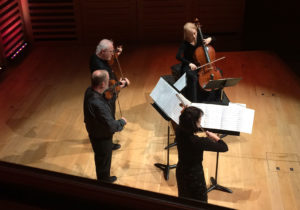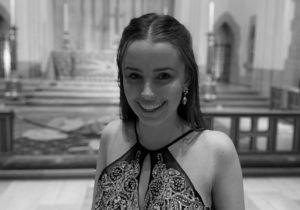Brodsky Quartet: Rush-Hour Lates Series – Review of the Opening Concert
Reviews
Our young journalist, Hannah Dienes-Williams, reviews the opening concert in the Brodsky Quartet’s brand-new Rush-Hour Lates series which consists of five compact 50-minutes concerts pairing Beethoven’s late string quartets with musical preludes.
As part of Kings Place’s programme celebrating the 250th anniversary of Beethoven, a series of ‘rush-hour concerts’ featuring all of the late quartets caught my attention. The compact nature of these concerts appealed to me: practically speaking, they are easy to slot into an evening without much hassle, while allowing a focus on each quartet in its autonomy.
‘The compact nature of these concerts appealed to me: they are easy to slot into an evening without much hassle’
Beethoven’s last quartets, in the words of the Brodsky Quartet, are ‘the peak’ when it comes to performing chamber music. While the Choral Symphony, completed a year before Opus 127 premiered, is colossal in its forces, the five late quartets are comparatively enigmatic. Cassidy chose to speak a little about the late quartets before playing which engaged the audience effectively with the context of these works – Beethoven’s ill health and deafness – as well as conveying the significance of working on the quartets as a group.
Before Opus 127, the quartet performed Karen Tanaka’s At the Grave of Beethoven, a two-movement work. The piece was mournful in places and vibrant in others; the first movement is based on the first four bars of Beethoven’s Opus 18 No. 3 with a few nods to Beethoven’s more ethereal writing. The Brodsky’s interpretation allowed the first movement to travel, melodies naturally soaring and oscillating quaver textures floating as if airborne. If this movement was a journey for quartet and audience alike, the destination was the second movement – a time-capsule into Beethoven’s more intimate sound-world. This movement was more static, the four-note melodic figure maintaining a simple melancholic and nostalgic mood. A beautiful juxtaposition of major and minor, this piece prepared for some of the sounds to follow in Opus 127, showcasing Tanaka’s ability to transport an audience to a different world while remaining rooted in her own contemporary style.
‘Karen Tanaka’s At the Grave of Beethoven demonstrated the composer’s ability to transport an audience to a different world’
A quartet must be comprised of extremely skillful musicians to grasp the immense magnitude of Beethoven’s late quartets and to communicate something of the sublime in them. The Brodsky’s performance certainly fulfilled this – their energy never faltered, captivating the entire hall with their constant communication and sensitivity. The Brodsky’s choice to stand when playing (with cellist Jacqueline Thomas on a platform) is unusual but not at all compromising – it seemed to allow them greater freedom and dynamic energy when playing. I found this particularly effective for Cassidy: despite the viola’s notorious difficulty being heard within the texture, all four parts stood out well when they needed to.
‘The Brodsky Quartet captivated the entire hall with their constant communication and sensitivity’
The first movement had a bold elegance about it – the piece moves through passages of lyricism as well as of attack, each culminating in or relieved by dramatic declarations of the opening bars. The ending was suitably casual – often Beethoven uses a surprise, fortissimo exclamation at the end of his first movements, but here it is unemphatic – the Brodskys trailed off with a neat satisfaction, preparing the tone for the following movement.
For me, the beginning of the second movement is one of the most serene moments of Beethoven’s whole output – while his fast movements are often fierce, humorous or bold, I find the slow movements from his late period to be the most precious and intimate. Beginning with a sense of repose, it builds up from a whispering E flat pedal in the cello. The Brodsky’s sound was constantly warm, creating utter stillness through sustained pianissimo phrases yet maintaining the sense of hallowed mystery in the rhythmic ambiguity at the beginning. This evolves into two simple eight-bar phrases shared between violin and cello – the textural balance here allowed the melody and countermelody to drift as if both players were moving along an independent train of thought. Each variation had a distinct character, the second more lively, a dialogue between the violins, against a bouncing accompaniment. After two more ethereal variations, the extended coda arrives with moments of extremely bare texture – the sotto voce here was particularly effective in creating complete serenity until the very end – the silence in the hall afterwards was unbroken for a while.
The following scherzo immediately swept aside the previous movement’s tranquillity, demonstrating the quartet’s ability to create humorous conversation in a highly contrapuntal movement. It is witty and capricious: this was exaggerated effectively with outspoken assertions sometimes individually, sometimes in octave passages, as well as more enigmatic phrases with sudden dynamic contrasts. The trio is particularly unusual, appearing almost out of nowhere – particularly impressive were McCormack’s effortless rhapsodic passages in this section, which burst into boisterous major iterations. After a final attempt at the trio’s strain which stops abruptly, a comically sudden, demonstrative ending, generated a few amused chuckles from the audience.
‘Most striking was the incredible sonority just before the end, in a passage which suddenly seemed to rise into the sky’
The quartet presented the final movement with consistent vigour and genuine enjoyment shown through smiling glances at each other, but most striking was the incredible sonority just before the end, in a passage which suddenly seemed to rise into the sky, above the previously earthy sound. The lilt of the melody was magically transformed into more of a waltz, through trills and downwards passages played with complete lightness, almost reminiscent of the introverted second movement, when placed against the otherwise extroverted scheme of this final movement. Perhaps this was my favourite part of the whole performance, as it managed to capture something entirely new, right at the end. This moment demonstrated perfectly what the Brodsky had achieved all night, the ability to be both theatrical and engaging, while presenting the fleeting subtleties of this quartet.
Hannah Dienes-Williams
Hannah Dienes-Williams is 18 years old, studying for A Levels in Music, English Literature and French at Guildford High School. She is a first study singer and second study violinist with a particular passion for chamber music. She enjoys writing about music and hopes to pursue a career in singing.

